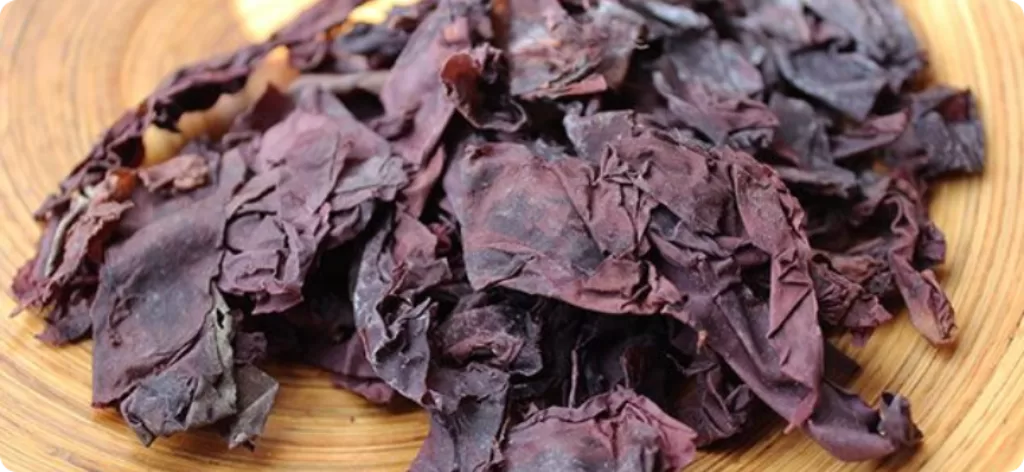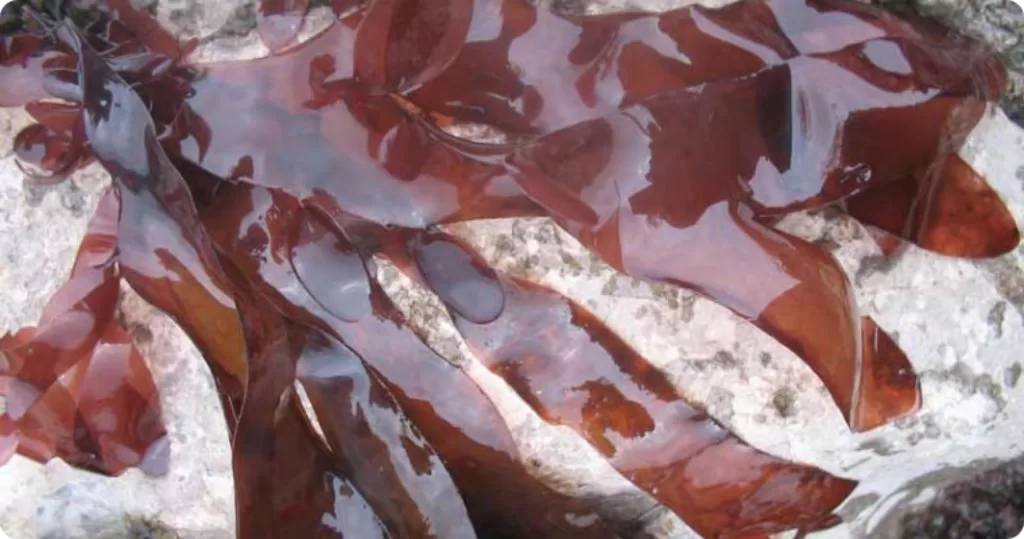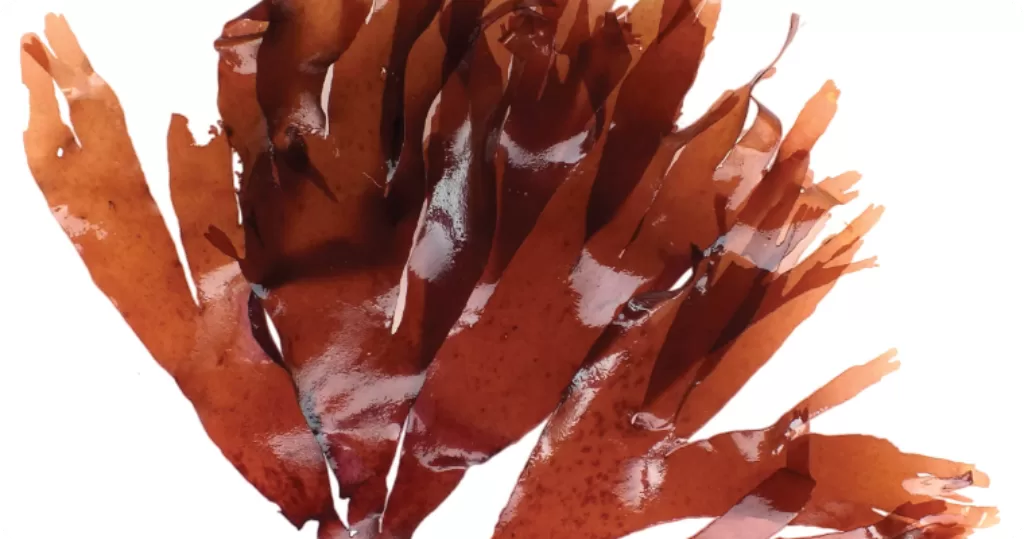Palmaria palmata (Dulse / Dillisk / Dilsk)

Characteristics
Palmaria palmata is a red algae of the family Palmariaceae that is commonly found along the northern coasts of the Atlantic and Pacific Oceans. It is considered an important alternative food source and delicacy and has been harvested for this purpose for centuries.
Its common name is dulce (spelled as dillisk
or dilsk in Scotland and Ireland). It is also known as red dulse, sea lettuce flakes, or creathnach. The fronds of P. palmata vary in shape, are leathery in texture, and range in color from deep rose to reddish purple. The flat blades of the fronds expand from the base and divide into segments that grow to an average of 20–50 centimeters in length. The average width of the fronds is 3–8 centimeters.

Geographical spread & harvest season in Europe
Palmaria palmata grows naturally throughout Britain and Ireland, but seems to be absent from wide stretches of coastline in eastern England. Globally, it can be found along sheltered and moderately exposed Atlantic coasts, from Arctic Russia to Portugal. It thrives in North America, from Arctic Canada to New Jersey on the Atlantic coast, and from Alaska to California on the Pacific coast. Dulse is also commonly found and harvested in Japan and Korea.

P. palmata is a perennial species, with new growth every year. Therefore, both naturally-occurring and cultivated holdfasts can remain active and productive for several years. It can be harvested as early as June, but its normal harvest season is September to April. When harvested, portions of the fronds are left behind so that the plant will continue to grow.
Nutritional content
Palmaria palmata has been a food source for thousands of years, and is considered to be a good source of dietary requirements. It is high in protein and fibre, and its protein quality is comparable to vegetables of good nutritional value.

Dulse is also rich in calcium, potassium, iron, Vitamin A (as carotene), Vitamin C, iodine, and trace elements. It has a salty taste, but is relatively low in sodium, which is why it is often used as a salt substitute. A small amount of dulse can provide more than 100% of the Recommended Daily Allowance of Vitamin B6, and 66% of the RDA of iron, Vitamin B12, and fluoride. Its significant levels of calcium and potassium help strengthen your bones and make them more resilient.
P. palmata has been found in studies to help lower blood pressure, improve eyesight, and improve the health of the thyroid gland. Its high levels of Vitamin B12 are important because most sources of that vitamin come from meat sources, forcing vegetarians to take supplements to compensate for the lack of meat in their diets. Dulse has been shown to be a natural alternative to these supplements. Many dieticians and nutritionists advise including dulse in your diet because the anti-oxidants it contains significantly boost your immune system.
One of the primary nutritional benefits of dulse is its practicality, because it is so easy to incorporate it into your diet. It requires no particular cooking efforts, and can be enjoyed "as is," in either leaf form or as dried flakes. This makes it easy to add to dishes like salads, salad dressings, and dips.
Use cases in food
Palmaria palmata has a long history of use as a food source. The earliest records of it come from Iona, Scotland, where it was harvested by Christian monks over 1,400 years ago. It is also widely popular in Asia -- as a snack food, as a tasty sea vegetable, and as a flavour enhancer or seasoning.
- In Iceland, it is commonly eaten as a vegetable, with butter. In other areas, it is pan-fried into chips, oven-baked and covered with cheese. It is remarkably flexible, often being included in soups, chowders, sandwiches, and salads, or added to bread or pizza dough.
- Researchers from Oregon State University’s Hatfield Marine Science Center have characterised dulse as a "superfood, with twice the nutritional value of kale." One variety of dulse is gaining a great deal of interest, because when fried, it tastes like bacon, not seaweed.
Use cases other than food
Although historically the primary uses of Palmaria palmata has been as a primary or supplemental food source, other uses are becoming more common:
- Dulse is used as animal feed in a number of countries, and as agricultural and garden fertilisers.
- In skin care products, P. palmata is turned into an extract by macerating the plant in water and then running it through a centrifuge to obtain the essential nutrients of the plant. The extract's high levels of folate, magnesium, calcium, iron, pantothenic acid (Vitamin B5), and amino acids stimulate the skin, promote cell growth, and improve skin appearance.
- Palmaria palmata extract is a “film former,” used to give lotions and creams a smooth, rich, unbroken texture. This approach allows nutrients in these products to be more easily absorbed and processed. It is also a natural emollient, which means that it helps to attract moisture from the environment to the skin, helping to protect it from environmental damage and keeping its texture smooth and supple.
- As a result of these properties, dulse is often used as an ingredient in face cleansers, moisturisers, eye gels, massage oils, and bath salts. It is also used in soaps, cleansing creams, shampoos and conditioners, hand creams, and shaving creams.
Biological Traits Information Catalogue, "BIOTIC Species Information for Palmaria palmata" Accessed 5 April 2021. http://www.marlin.ac.uk/biotic/browse.php?sp=4241
Rolin, C., Inkster, R., Laing, J. "Seaweed Cultivation Manual" NAFC Marine Center. https://www.nafc.uhi.ac.uk/t4-media/one-web/nafc/research/document/seaweed-cultivation/Seaweed-Cultivation-Manual.pdf
Netalgae.eu. "Seaweed Industry in Europe" www.netalgae.eu. Accessed 13 April 2021. https://www.seaweed.ie/irish_seaweed_contacts/doc/Filieres_12p_UK.pdf
Seaweed & Co. "The benefits of dulse are making waves" Accessed 9 April 2021. https://www.seaweedandco.com/the-benefits-of-dulse-are-making-waves/
Regan, H. "New Seaweed Tastes 'Like Bacon' and Is Healthier Than Kale". TIME.com. https://time.com/3960421/seaweed-bacon-dulse-kale-super-food/
Guiry, MD, Guiry, GM. "Palmaria palmata (Linnaeus) Weber & Mohr, 1805". AlgaeBase. National University of Ireland, Galway. World Register of Marine Species. http://www.marinespecies.org/aphia.php?p=taxdetails&id=145771
Seaweed.ie. "Palmaria palmate (Linnaeus) Weber & Mohr" The Seaweed Site: information on marine algae. https://www.seaweed.ie/descriptions/Palmaria_palmata.php
NIOZ. "Palmaria palmata" Royal Netherlands Institute for Sea Research. Accessed 9 April 2021. https://www.nioz.nl/en/research/expertise/seaweed-centre/media-background/north-sea-seaweed-species/palmaria-palmata
MarLIN. "Dulse (Palmaria palmate)" The Marine Life Information Network. Accessed 9 April 2021. https://www.marlin.ac.uk/species/detail/1405
Bjarnadóttir, M., Aðalbjörnsson, B.V., Nilsson, A. et al. Palmaria palmata as an alternative protein source: enzymatic protein extraction, amino acid composition, and nitrogen-to-protein conversion factor. J Appl Phycol 30, 2061–2070 (2018). https://link.springer.com/article/10.1007/s10811-017-1351-8
Skincare Lab. "Palmaria Palmata Extract in Skin Care – Benefits & Uses" Accessed 9 April 2021. https://www.skincarelab.org/palmaria-palmata-extract/
Keith C. Morgan, et al. “Review of Chemical Constituents of the Red Alga Palmaria Palmata (Dulse).” Economic Botany, vol. 34, no. 1, 1980, pp. 27–50. JSTOR, www.jstor.org/stable/4254136. Accessed 9 Apr. 2021. https://www.jstor.org/stable/4254136?seq=1